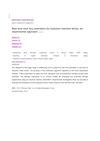Analysis and Implementation of Switched Capacitor-based Multi-Level Inverter for Electric Vehicles Applications
IF 0.9
4区 工程技术
Q4 ENGINEERING, ELECTRICAL & ELECTRONIC
引用次数: 3
Abstract
Significant interest has been shown in switched capacitor (SC)-based multi-level inverters (MLIs), which decrease the need for a DC supply and enhance power quality. The common issues with SC-MLIs include an uneven distribution of conducting paths, increased voltage drop across capacitors, the sum of all inverter DC link voltages across the highest voltage rated switches, and a higher total standing voltage (TSV). The purpose of this paper is to create a SC-MLI with less components in order to maintain a constant voltage across the capacitors, to obtain higher voltage gain with fewer parts, fewer conducting routes, lower TSV, and to create a more affordable and effective inverter. The structure of the MLI is created by a cascade interconnection between the number of SC cells. A single input multiple output (SIMO) converter boosts the DC-link voltage over the stable DC voltage of the solar panels using a modified perturb and observe (P&O) method. Additionally, fewer switches in the conduction path and 50 % of the switches operating at normal frequency guarantee a decrease in an overall loss of power in the proposed network. The benefits of the recommended MLI are made clear by comparing them with 17-level MLIs in terms of the number of elements, stress, gain, and cost factor. Detailed experimental results are shown under various transient conditions to show that the 17-level prototype is operationally viable. The total harmonic distortion (THD) is found to be identical and is less than 5 %, which meets IEEE standards.基于开关电容的电动汽车多级逆变器的分析与实现
人们对基于开关电容器(SC)的多电平逆变器(MLI)表现出了极大的兴趣,它减少了对直流电源的需求并提高了电能质量。SC MLI的常见问题包括传导路径分布不均、电容器两端的压降增加、最高电压额定开关两端的所有逆变器直流链路电压之和以及较高的总耐受电压(TSV)。本文的目的是创建具有较少组件的SC-MLI,以保持电容器两端的恒定电压,以获得具有较少部件、较少导电路径、较低TSV的较高电压增益,并创建更经济有效的逆变器。MLI的结构是通过SC单元数量之间的级联互连来创建的。单输入多输出(SIMO)转换器使用改进的扰动和观察(P&O)方法将直流链路电压提高到太阳能电池板的稳定直流电压之上。此外,传导路径中更少的开关和50%在正常频率下工作的开关保证了所提出的网络中总功率损耗的降低。通过将建议的MLI与17级MLI在元素数量、应力、增益和成本因素方面进行比较,可以清楚地说明其优点。详细的实验结果表明,在各种瞬态条件下,17级原型是可行的。总谐波失真(THD)被发现是相同的,并且小于5%,这符合IEEE标准。
本文章由计算机程序翻译,如有差异,请以英文原文为准。
求助全文
约1分钟内获得全文
求助全文
来源期刊

Elektronika Ir Elektrotechnika
工程技术-工程:电子与电气
CiteScore
2.40
自引率
7.70%
发文量
44
审稿时长
24 months
期刊介绍:
The journal aims to attract original research papers on featuring practical developments in the field of electronics and electrical engineering. The journal seeks to publish research progress in the field of electronics and electrical engineering with an emphasis on the applied rather than the theoretical in as much detail as possible.
The journal publishes regular papers dealing with the following areas, but not limited to:
Electronics;
Electronic Measurements;
Signal Technology;
Microelectronics;
High Frequency Technology, Microwaves.
Electrical Engineering;
Renewable Energy;
Automation, Robotics;
Telecommunications Engineering.
 求助内容:
求助内容: 应助结果提醒方式:
应助结果提醒方式:


